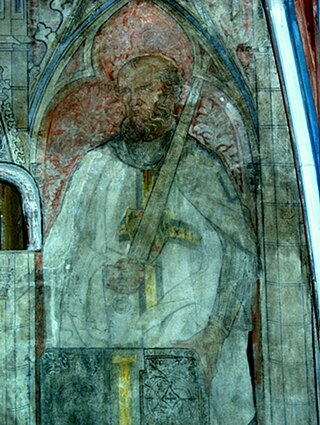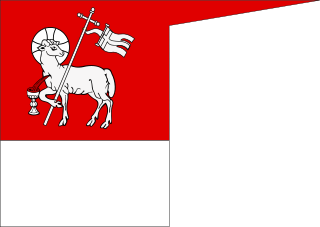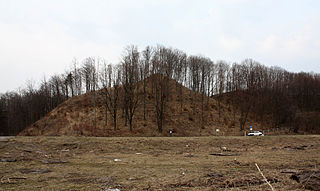Related Research Articles

The Teutonic Order is a Catholic religious institution founded as a military society c. 1190 in Acre, Kingdom of Jerusalem. The Order of Brothers of the German House of Saint Mary in Jerusalem was formed to aid Christians on their pilgrimages to the Holy Land and to establish hospitals. Its members have commonly been known as the Teutonic Knights, having a small voluntary and mercenary military membership, serving as a crusading military order for the protection of Christians in the Holy Land and the Baltics during the Middle Ages.

The Sambians were a Prussian tribe. They inhabited the Sambia Peninsula north of the city of Königsberg. Sambians were located in a coastal territory rich in amber and engaged in trade early on. Therefore, they established contacts with foreign nations before any other Prussians. However, as all other Prussians, they were conquered by the Teutonic Knights, and, exposed to assimilation and Germanization, became extinct sometime in the 17th century.

The Nadruvians were a now-extinct Prussian tribe. They lived in Nadruvia, a large territory in northernmost Prussia. They bordered the Skalvians on the Neman (Nemunas) River just to the north, the Sudovians to the east, and other Prussian tribes to the south and west. Most information about the clan is provided in a chronicle by Peter von Dusburg.

Luther von Braunschweig was the 18th Grand Master of the Teutonic Order, serving from 1331 until his death.

Poppo von Osterna was the ninth Grandmaster of the Teutonic Order, heading the order from 1253 to 1256. Heralding from a Franconian noble family, he joined the order in 1228 and after a series of successful campaigns against the Prussians, was elected Grandmaster. His reign was marked by his attempts to consolidate the Teutonic Order in Prussia, which did ultimately become the order's center until the 16th century.

Pogesanians were a Prussian tribe, which lived in the region of Pogesania, a small territory stretched between the Elbląg and Pasłęka rivers, now located in the Warmian-Masurian Voivodeship, northern Poland. Pogesanians, as the rest of the Prussians, were conquered by the Teutonic Knights and became Germanized or Polonized. The old Prussian language became extinct sometime in the 17th century.

The Prussian uprisings were two major and three smaller uprisings by the Old Prussians, one of the Baltic tribes, against the Teutonic Knights that took place in the 13th century during the Prussian Crusade. The crusading military order, supported by the Popes and Christian Europe, sought to conquer and convert the pagan Prussians. In the first ten years of the crusade, five of the seven major Prussian clans fell under the control of the less numerous Teutonic Knights. However, the Prussians rose against their conquerors on five occasions.

The siege of Königsberg was a siege laid upon Königsberg Castle, one of the main strongholds of the Teutonic Knights, by Prussians during the great Prussian uprising from 1262 possibly though 1265.

The Prussian Crusade was a series of 13th-century campaigns of Roman Catholic crusaders, primarily led by the Teutonic Knights, to Christianize under duress the pagan Old Prussians. Invited after earlier unsuccessful expeditions against the Prussians by Christian Polish kings, the Teutonic Knights began campaigning against the Prussians, Lithuanians and Samogitians in 1230. By the end of the century, having quelled several Prussian uprisings, the Knights had established control over Prussia and administered the conquered Prussians through their monastic state, eventually erasing the Prussian language, culture and pre-Christian religion by a combination of physical and ideological force. Some Prussians took refuge in neighboring Lithuania.
Nikolaus von Jeroschin was a 14th-century German chronicler of the Teutonic Knights in Prussia.

The Bishopric of Samland (Sambia) was a bishopric in Samland (Sambia) in medieval Prussia. It was founded as a Roman Catholic diocese in 1243 by papal legate William of Modena. Its seat was Königsberg, until 1523 the episcopal residence was in Fischhausen. The bishopric became Lutheran in the 16th century during the Protestant Reformation and was eventually dissolved following the establishment of Ducal Prussia, a Protestant vassal duchy of the Kingdom of Poland.

The Prince-Bishopric of Warmia was a semi-independent ecclesiastical state, ruled by the incumbent ordinary of the Warmia see and comprising one third of the then diocesan area. The Warmia see was a Prussian diocese under the jurisdiction of the Archbishopric of Riga that was a protectorate of the Monastic state of the Teutonic Knights (1243–1464) and a protectorate and part of the Kingdom of Poland—later part of the Polish–Lithuanian Commonwealth (1464–1772), confirmed by the Peace of Thorn in 1466. The other two thirds of the diocese were under the secular rule of the Teutonic Knights until 1525 and Ducal Prussia thereafter, both entities also being a protectorate and part of Poland from 1466.

Bisenė or Bisena was a wooden fortress of the Grand Duchy of Lithuania during the Lithuanian Crusade. It was one of the Lithuanian defensive outposts along the Neman River and was burned down by the Teutonic Order in 1283 and 1316. Its location was long debated and often confused with Pieštvė, but after 1985 research of Romas Batūra it has been generally accepted to be Kartupėnai Hillfort near the confluence of the Kartupis and Neman in Jurbarkas District Municipality, Lithuania. After the burning down of Kolainiai in 1291 and Bisenė in 1316, Junigeda (Veliuona) became the westernmost Lithuanian fortress along the Neman.

Landmeister in Livland was a high office in the Teutonic Order. The Landmeister administered the Livonia of the Teutonic Order. These lands had fallen to the Teutonic Order in 1237 by the incorporation of the former Livonian Brothers of the Sword. The seat of the Landmeister was castle Wenden. The Landmaster's function in Livonia lasted until 1561, when in aftermath of Livonian War the last Landmeister Gotthard Kettler relinquished the northern parts of the Mastery and in the Union of Vilna secularized the part still left to him and, as the Duchy of Courland and Semigallia, took fief from the Polish king and Grand Duke of Lithuania Sigismund II Augustus. The non-recognition of this act by Pope, Holy Roman Empire and the Grand Master of the Teutonic Order had no factual effect.
Dietrich von Grüningen was a Knights Templar, Landmeister in Livonia and Landmeister of Prussia and Deutschmeister of the Teutonic Order. One of the most outstanding figures of the Teutonic Order in the 13th century.
Stenckel von Bentheim, also known as Sсhenckel von Bentheim and Seno von Bynthausen, was a knight of Westphalia mentioned in The Chronicle of the Prussian Land by Peter of Dusburg and the eponymous The Chronicle of Prussia by Nikolaus von Jeroschin. He took part as a so-called guest knight in the Prussian Crusade and died in the Battle of Pokarwis in 1261, as described by Peter of Dusburg and Nikolaus von Jeroschin in the aforementioned chronicles:
The brothers and the Christians fought back valiantly, particularly one, a good pure knight called Lord Schenckel of Bentheim who came from Westphalia. He had heard a bishop there preaching to the people that all of the Christian souls who were killed by the heathens in Prussia entered heaven directly without going through purgatory. This reward was precious above all others to this knight. He spurred on his horse and charged, carrying his spear as knights do, and charged through the enemy front line and into the main army. His charge inflicted serious injury on many Prussians; his sharpedged salute killed many on both sides. When he had charged through them, and he was turning back and had reached the middle of the army, this laudable warrior of God was knocked down.
The Battle of Wopławki or Woplauken was fought on 7 April 1311 in the area near the village of Woplauken, north-east of Kętrzyn, as Belorusian historian Ruslan Gagua states in Annalistic Records on the Battle of Wopławki The battle definitely had become a major and significant one by medieval standards during the military confrontation of the Teutonic Order and the then Lithuania, according to The Nature of the Conduct of Warfare in Prussian and Lithuanian Borderlands at the Turn of the 13th and 14th Centuries by Ruslan Gagua.
Ludwig von Liebenzell was a knight of the Teutonic Order in the 13th century. He was a Komtur of Ragnit in Prussia from 1294 to 1300.
Bertold Brühaven, also known as Berthold von Brühaven or Berthold von Bruehaven, was a Teutonic knight hailed from the then Duchy of Austria; served in Prussia as the Komtur of Balga in 1288–1289, the first Komtur of Ragnit in 1289, then the Komtur of Königsberg in from 1289 to 1302.

Burkhard von Hornhausen was from 1257 to 1260 Landmeister in Livonia of the Teutonic Order. He was the first commander and directed the construction of the Königsberg Castle.
References
- ↑ Chronicon terrae Prussiae by Peter of Dusburg, III, 68 (in Russian)
- ↑ A History of the Teutonic Knights in Prussia 1190-1331: The Kronike Von Pruzinlant by Nikolaus von Jeroschin, Lines 9,729–98; III, 68 (in English)
- ↑ The Chronicle of Prussia by Nikolaus von Jeroschin, Lines 9,729–98; III, 68 (in English)